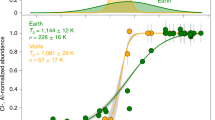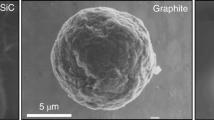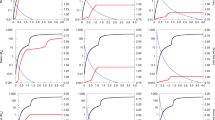Abstract
Chondrules are millimetre-sized spherules (mostly silicate) that dominate the texture of primitive meteorites1. Their formation mechanism is debated, but their sheer abundance suggests that the mechanism was both energetic and ubiquitous in the early inner Solar System2. The processes suggested—such as shock waves, solar flares or nebula lightning3,4,5,6,7—operate on different length scales that have been hard to relate directly to chondrule properties. Chondrules are depleted in volatile elements, but surprisingly they show little evidence for the associated loss of lighter isotopes one would expect8. Here we report a model in which molten chondrules come to equilibrium with the gas that was evaporated from other chondrules, and which explains the observations in a natural way. The regions within which the chondrules formed must have been larger than 150–6,000 km in radius, and must have had a precursor number density of at least 10 m-3. These constraints probably exclude nebula lightning, and also make formation far from the nebula midplane problematic. The wide range of chondrule compositions may be the result of different combinations of the local concentrations of precursors and the local abundance of water ice or vapour.
This is a preview of subscription content, access via your institution
Access options
Subscribe to this journal
Receive 51 print issues and online access
$199.00 per year
only $3.90 per issue
Buy this article
- Purchase on Springer Link
- Instant access to full article PDF
Prices may be subject to local taxes which are calculated during checkout

Similar content being viewed by others
References
Jones, R. H., Grossman, J. N. & Rubin, A. E. in Chondrules and the Protoplanetary Disk (eds Krot, A. N., Scott, E. R. D. & Reipurth, B.) Vol. 341, 251–316 (Astron. Soc. Pacif. Conf. Ser., San Francisco, 2005)
Ciesla, F. in Chondrules and the Protoplanetary Disk (eds Krot, A. N., Scott, E. R. D. & Reipurth, B.) Vol. 341, 811–820 (Astron. Soc. Pacif. Conf. Ser., San Francisco, 2005)
Desch, S. & Connolly, H. C. Jr. A model of the thermal processing of particles in solar nebula shocks; application to the cooling rates of chondrules. Meteor. Planet. Sci. 37, 183–207 (2002)
Ciesla, F. J., Hood, L. L. & Weidenschilling, S. Evaluating planetesimal bow shocks as sites for chondrule formation. Meteor. Planet. Sci. 39, 1809–1821 (2004)
Iida, A., Nakamoto, T., Susa, H. & Nakagawa, Y. A shock heating model for chondrule formation in a protoplanetary disk. Icarus 153, 430–450 (2001)
Nakamoto, T., Hayashi, M. R., Kida, N. T. & Tachibana, S. in Chondrules and the Protoplanetary Disk (eds Krot, A. N., Scott, E. R. D. & Reipurth, B.) Vol. 341, 883–892 (Astron. Soc. Pacif. Conf. Ser., San Francisco, 2005)
Desch, S. & Cuzzi, J. N. Formation of chondrules by lightning in the protoplanetary nebula. Icarus (PPIV special issue) 143, 87–105 (2000)
Davis, A. M., Alexander, C. M. O'D., Nagahara, H. & Richter, F. M. in Chondrules and the Protoplanetary Disk (eds Krot, A. N., Scott, E. R. D. & Reipurth, B.) Vol. 341, 432–455 (Astron. Soc. Pacific Conf. Ser., San Francisco, 2005)
Rayleigh, J. W. S. Theoretical considerations respecting the separation of gases by diffusion and other processes. Phil. Mag. 42, 493–498 (1896)
Richter, F. M., Davis, A. M., Ebel, D. S. & Hashimoto, A. Elemental and isotopic fractionation of type B calcium-aluminum-rich inclusions: Experiments, theoretical considerations, and constraints on their evolution. Geochim. Cosmochim. Acta 66, 521–540 (2002)
Alexander, C. M. O'D. Chemical equilibrium and kinetic constraints for chondrule and CAI formation conditions. Geochim. Cosmochim. Acta 68, 3943–3969 (2004)
Hewins, R. H., Connolly, H. C. Jr, Lofgren, G. E. & Libourel, G. in Chondrules and the Protoplanetary Disk (eds Krot, A. N., Scott, E. R. D. & Reipurth, B.) Vol. 341, 286–316 (Astron. Soc. Pacif. Conf. Ser., San Francisco, 2005)
Alexander, C. M. O'D. et al. The lack of potassium isotopic fractionation in Bishunpur chondrules. Meteorit. Planet. Sci. 35, 859–868 (2000)
Nagahara, H. & Ozawa, K. Isotopic fractionation as a probe of heating processes in the solar nebula. Chem. Geol. 169, 45–68 (2000)
Young, E. D. & Galy, A. The isotope chemistry and cosmochemistry of magnesium. Rev. Min. Geochem. 55, 197–235 (2004)
Ebel, D. S. & Grossman, L. W. Condensation in dust-enriched systems. Geochim. Cosmochim. Acta 64, 339–366 (2000)
Galy, A., Young, E. D., Ash, R. D. & O'Nions, R. K. The formation of chondrules at high gas pressures in the solar nebula. Science 290, 1751–1754 (2000)
Young, E. D. Isotopic cosmobarometry—a synthesis of concepts and implications for chondrule and CAI formation mechanisms. Lunar Planet. Sci. Conf. XXXV, abstr. 1300 [CDROM] (2004).
Jones, R. H., Lee, T., Connolly, H. C. Jr, Love, S. G. & Shang, H. in Protostars and Planets IV (eds Mannings, V., Boss, A. P. & Russell, S. S.) (Univ. Arizona Press, 2000)
Ciesla, F. J. & Hood, L. L. The nebular shock wave model for chondrule formation: shock processing in a particle-gas suspension. Icarus 158, 281–293 (2002)
Cuzzi, J. N., Hogan, R. C., Paque, J. M. & Dobrovolskis, A. R. Size-selective concentration of chondrules and other small particles in protoplanetary nebula turbulence. Astrophys. J. 546, 496–508 (2001)
Hood, L. L., Ciesla, F. J. & Weidenschilling, S. J. in Chondrules and the Protoplanetary Disk (eds Krot, A. N., Scott, E. R. D. & Reipurth, B.) Vol. 341, 873–882 (Astron. Soc. Pacif. Conf. Ser., San Francisco, 2005)
Cuzzi, J. N. & Zahnle, K. R. Material enhancement in protoplanetary nebulae by particle drift through evaporation fronts. Astrophys. J. 614, 490–496 (2004)
Ciesla, F. J. & Cuzzi, J. N. The evolution of the water distribution in a viscous protoplanetary disk. Icarus 181, 178–204 (2006)
Yurimoto, H. & Kuramoto, N. Molecular cloud origin for the oxygen isotope heterogeneity in the solar system. Science 305, 1763–1766 (2004)
Lyons, J. R. & Young, E. D. CO self-shielding as the origin of oxygen isotopic anomalies in the early solar nebula. Nature 435, 317–320 (2005)
Krot, A. N. et al. Evolution of oxygen isotopic composition in the inner solar nebula. Astrophys. J. 622, 1333–1342 (2005)
Acknowledgements
We thank E. Young for several discussions and A. Boss, L. Nittler, and F. Ciesla for comments which improved the manuscript. This work was supported by NASA's Planetary Geology and Geophysics, Origins of Solar Systems, and Cosmochemistry programmes.
Author information
Authors and Affiliations
Corresponding author
Ethics declarations
Competing interests
Reprints and permissions information is available at npg.nature.com/reprintsandpermissions. The authors declare no competing financial interests.
Supplementary information
Supplementary Notes
This file contains Supplementary Discussion on: general relationships and assumptions; solving for local density where clouds from many chondrules overlap; diffusion of evaporated vapor in hydrogen gas; high pressures can preclude isotopic fractionation; details of chemical kinetic models; other meteoritic properties leading to similar chondrule number densities; and how are high chondrule concentrations produced? (PDF 108 kb)
Rights and permissions
About this article
Cite this article
Cuzzi, J., Alexander, C. Chondrule formation in particle-rich nebular regions at least hundreds of kilometres across. Nature 441, 483–485 (2006). https://doi.org/10.1038/nature04834
Received:
Accepted:
Issue Date:
DOI: https://doi.org/10.1038/nature04834
This article is cited by
-
Transforming Dust to Planets
Space Science Reviews (2018)
-
Impact jetting as the origin of chondrules
Nature (2015)
-
How to make a chondrule
Nature (2006)
Comments
By submitting a comment you agree to abide by our Terms and Community Guidelines. If you find something abusive or that does not comply with our terms or guidelines please flag it as inappropriate.



